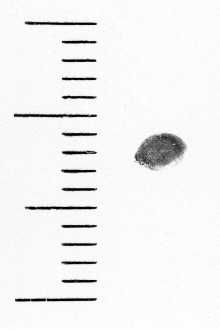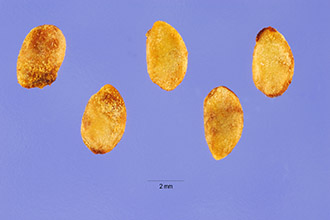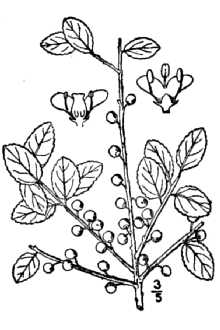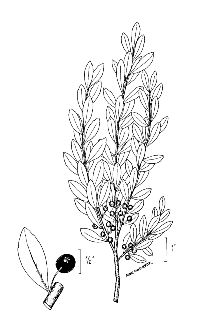Inkberry
Scientific Name: Ilex glabra (L.) A. Gray

| General Information | |
|---|---|
| Usda Symbol | ILGL |
| Group | Dicot |
| Life Cycle | Perennial |
| Growth Habits | Shrub |
| Native Locations | ILGL |
Plant Guide
Uses
Inkberry leaves are browsed by marsh rabbit and white tailed-deer, the fruits are important food for raccoon, coyote, and opossum when other sources are scarce. The fruit is also eaten by at least 15 species of birds, including bobwhite quail and wild turkey. Inkberry provides cover for white-tailed deer, small rodents, and several species of birds. Nectar of the flowers is an important source for honey production. Inkberry is coming to be recommended and used for ornament as one of the few evergreen shrubs that thrives in continually moist to wet sites and adapts to a wide range of light availability. It provides a larger and faster growing alternative to boxwood hybrids, although it tends to be leggier, prone to stem breakage, and the rhizomatous plants tend to form large, expanding colonies. Numerous cultivars of inkberry have been selected and are commercially available. Compared to the wild types, these generally have a more compact, taller, and/or broader habit, smaller and darker leaves, greater cold hardiness, and/or more abundant fruit production. Selections are sometimes restricted to one or the other sex, and because the staminate and pistillate flowers are on different plants, both sexes must be present for fruit production. © William S. Justice Botany Dept., NMNH, Smithsonian Institution @ PLANTS Inkberry can be used for erosion control, watershed protection, and phosphate mine reclamation. It is included in listings of potential new crops for Australia as a source of beverage -- presumably desirable for its caffeine. The fruit and leaves of various species of holly, presumably including inkberry, contain a mixture of the caffeine-like alkaloid theobromine, caffeine itself, and glycosides. The Indians of the southeastern US made a caffeinated tea from the leaves of yaupon holly (Ilex vomitoria). Mate, or Paraguay tea, is made from the leaves of Ilex paraguariensis, a holly tree indigenous to Argentina, Brazil, and Paraguay. Mate contains caffeine and a natural alkaloid called mateine, a mildly stimulating relative of caffeine that tends not to produce side effects such as nervousness or sleeplessness.
Status
Please consult the PLANTS Web site and your State Department of Natural Resources for this plant’s current status, such as, state noxious status and wetland indicator values.
Description
General: Holly family (Aquifoliaceae), Native, open evergreen shrubs, commonly growing 1, Use soil moisture sensors to measure the soil moisture of Inkberry.,5-2(-3) meters tall, with numerous sprouts from thick, heavy, tuberous rhizomes, forming clusters and extensive, dense, colonial thickets, Leaves are alternate, simple, entire or finely toothed toward the tip, obovate to oblong or elliptic, 2,5-6,5 cm long, evergreen, leathery, shiny and dark green above, lighter and dull beneath, Flowers are either staminate (male) or pistillate (female), borne on separate plants (the species dioecious); individual flowers small, greenish-white and inconspicuous, the staminate 3-7 in short-stalked clusters, the pistillate solitary in leaf axils, Fruit is 5-7 mm in diameter, nearly black, shiny; seeds (pyrenes) 5-7, smooth, The common name is in reference to the dark blue-black fruits,
Distribution
Inkberry occurs on the coastal plain of all US states along the Atlantic and Gulf coasts, from Texas to Florida and northward to southern New Jersey, Maryland, and Delaware, including more inland localities in Pennsylvania and Arkansas. It continues northward sporadically and uncommonly through New England into Nova Scotia, Canada.
Establishment
Adaptation: Inkberry occurs primarily in pocosins, savannas, low woods, and pine barrens and woodlands. It is a common understory species of several fire-climax communities and an invader of frequently burned areas. On well-drained sites of bayland and pocosin communities, it is a dominant species. It is a common shrub in loblolly-shortleaf pine communities, and with Wiregrass (Aristida stricta), it may be one of the most conspicuous members of the understory of longleaf pine forests in Florida. Inkberry is shade tolerant and grows in both sunny and shaded habitats, on dry to wet sites, and on sandy to heavier peaty soils. Flowering: March-June; fruiting: September-October, the fruits persisting into the following spring. General: Wildlife use of inkberry and the colonization of a variety of habitats suggest that the seeds are animal dispersed. Germination may not occur for 2-3 years, and seedling growth and early development are slow. Seedlings apparently grow best in partial shade.
Management
Fire top-kills inkberry but the species is adapted to a regime of recurrent fires. Typically, the entire aerial portion of the stem dies, although light fires may only kill the most recent growth. Re-growth occurs by resprouting from root crowns and rhizomes, most vigorously in the first post-fire year. Control: Successive annual fires will effectively kill inkberry, when management for cattle and commercial tree production call for complete control. Summer fires are most damaging but frequent winter fires also are effective for control. Cultivars, Improved and Selected Materials (and area of origin) Contact your local Natural Resources
Conservation
Service (formerly Soil Conservation Service) office for more information. Look in the phone book under ”United States Government.” The Natural Resources Conservation Service will be listed under the subheading “Department of Agriculture.” These plant materials are somewhat available from commercial sources.
References
Brizicky, G.K. 1964. The genera of Celastrales in the southeastern United States. J. Arnold Arb. 45:206-234. Coladonato, M. 1991. Ilex glabra. IN: W.C. Fischer (compiler). The fire effects information system [Data base]. U.S. Dept. of Agric., Forest Service, Intermountain Research Station, Intermountain Fire Sciences Laboratory, Missoula, Montana. <http://www.fs.fed.us/database/feis/> Dirr, M.A. 1986. Ilex glabra. American Nurseryman 164 (10):134 (with illust.). Dirr M.A. & J.H. Alexander 1991. Ilex glabra, the inkberry holly. Arnoldia (Jamaica Plain) 51:16-22. Florida Water Resource Management 1999. Florida’s hollies. Florida Dept. of Environmental Protection, Internet site: <http://www.dep.state.fl.us/water/slerp/wetlands/Ilex. htm> Perry, F.B. 1983. Propagation of Ilex glabra and Rhododendron nudiflorum from softwood cuttings. Research report series - Alabama Agricultural Experiment Station, Auburn University, Auburn, Alabama. Woods, F.W. 1956. Ilex glabra forma leucocarpa: A white-fruited holly. Rhodora 58:25-26.
Plant Traits
Growth Requirements
| Temperature, Minimum (°F) | -13 |
|---|---|
| Adapted to Coarse Textured Soils | Yes |
| Adapted to Fine Textured Soils | Yes |
| Adapted to Medium Textured Soils | Yes |
| Anaerobic Tolerance | High |
| CaCO3 Tolerance | Medium |
| Cold Stratification Required | Yes |
| Drought Tolerance | Low |
| Fertility Requirement | Medium |
| Fire Tolerance | Low |
| Frost Free Days, Minimum | 165 |
| Hedge Tolerance | Medium |
| Moisture Use | High |
| pH, Maximum | 7.0 |
| pH, Minimum | 4.5 |
| Planting Density per Acre, Maxim | 2700 |
| Planting Density per Acre, Minim | 1200 |
| Precipitation, Maximum | 60 |
| Precipitation, Minimum | 32 |
| Root Depth, Minimum (inches) | 16 |
| Salinity Tolerance | Medium |
| Shade Tolerance | Intolerant |
Morphology/Physiology
| Bloat | None |
|---|---|
| Toxicity | None |
| Resprout Ability | No |
| Shape and Orientation | Erect |
| Active Growth Period | Summer and Fall |
| C:N Ratio | High |
| Coppice Potential | No |
| Fall Conspicuous | No |
| Fire Resistant | Yes |
| Flower Color | White |
| Flower Conspicuous | No |
| Foliage Color | Green |
| Foliage Porosity Summer | Moderate |
| Foliage Porosity Winter | Porous |
| Foliage Texture | Coarse |
| Fruit/Seed Conspicuous | Yes |
| Nitrogen Fixation | None |
| Low Growing Grass | No |
| Lifespan | Long |
| Leaf Retention | Yes |
| Known Allelopath | No |
| Height, Mature (feet) | 8.0 |
| Height at 20 Years, Maximum (fee | 5 |
| Growth Rate | Slow |
| Growth Form | Multiple Stem |
| Fruit/Seed Color | Black |
Reproduction
| Vegetative Spread Rate | None |
|---|---|
| Small Grain | No |
| Seedling Vigor | Low |
| Seed Spread Rate | Slow |
| Fruit/Seed Period End | Fall |
| Seed per Pound | 29000 |
| Propagated by Tubers | No |
| Propagated by Sprigs | No |
| Propagated by Sod | No |
| Propagated by Seed | Yes |
| Propagated by Corm | No |
| Propagated by Container | Yes |
| Propagated by Bulb | No |
| Propagated by Bare Root | Yes |
| Fruit/Seed Persistence | Yes |
| Fruit/Seed Period Begin | Summer |
| Fruit/Seed Abundance | Medium |
| Commercial Availability | Routinely Available |
| Bloom Period | Spring |
| Propagated by Cuttings | No |
Suitability/Use
| Veneer Product | No |
|---|---|
| Pulpwood Product | No |
| Protein Potential | Low |
| Post Product | No |
| Palatable Human | No |
| Palatable Graze Animal | Low |
| Palatable Browse Animal | Low |
| Nursery Stock Product | Yes |
| Naval Store Product | No |
| Lumber Product | No |
| Fodder Product | No |
| Christmas Tree Product | No |
| Berry/Nut/Seed Product | No |



